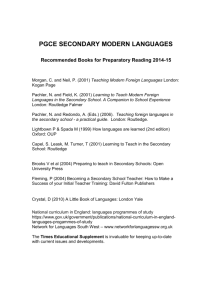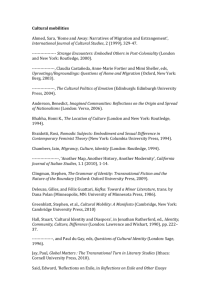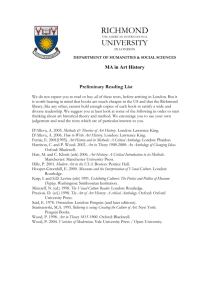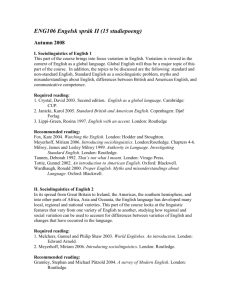Intro_to_English_SS
advertisement
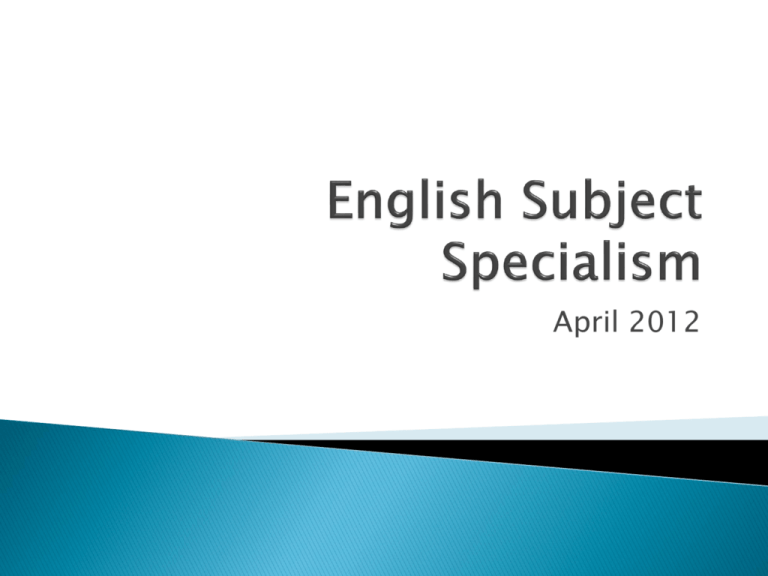
April 2012 Year Semester 1 Semester 2 2 Subject study 1: PR2960EL Language Culture and Society Subject study 2: PR2960EL Children’s Literature 3 7 Subject study 3: PR2960EL Media Language and Multiliteracies Subject study 4: PR2960EL Curriculum Leadership in English My use of English and the history of English Introduction to the module . History of English language: Professor Christopher Mulvey. Seminar: Group feedback on pre-module task (personal language history) .The place of Standard English in the NC Introduction to the patchwork assignment NF My use of English and my generation Our evolving spoken and written English and the impact of technology JR Children’s language development – first language First language development; session to take place in an early years setting MS Children’s language development- learning English when it is a second or subsequent language Second language acquisition NF and Liz Perry, former Headteacher of Kings Furlong Infant and Nursery School The structure of language- spoken and written Grammar lecture from Professor Christopher Mulvey Grammar seminar JR Children’s language- social and cultural differences and the school environment. Drawing together experiences in weeks 1 - 4. Comparing content of language writing patches. Reflection on differences between first and second language acquisition. Reflection on the impact of social difference and language acquisition. NF How children are supported in learning about the structures in their language Grammar resources in school Arranging groupings for grammar resource assignment NF Submit assignment 1 this week DT in school SE 2 weeks 8-11 related to grammar Support clinics for grammar resource assignment task for ( sign up before going on SE) NF assignment 2. 12 Group presentations of assignment 2 9 – 1 NF , MS and JR Assignment Question: What do primary school teachers need to know about language? Assignment Detail: Discuss, with reference to two/three different areas of knowledge about language, what teachers need to know about language and how this knowledge is relevant in the classroom. You may choose from: Standard spoken English and socio-cultural differences in use of English First language development Second language acquisition (EAL) The structure of English (grammar) Word count 2000 Assignment 2: Creating a resource for the teaching of grammar (2000 words equivalent) For this assignment you will work in a group of 3 or 4 and you will produce a resource for the teaching of grammar in KS 1 or 2. Using the examples shown to you in week 7, and those you have seen in school, you will choose just ONE aspect of grammar teaching and adapt it for ONE year group; You are advised to discuss the possible content with teachers on SE 2 using the detail of the directed task as outlined in the module handbook on page 4. August, D. and Shanahan, T. (2006) Developing literacy in second-language learners: report of the national literacy panel on language minority children and youth, Mahwah, NY: Lawrence Erlbaum Associates Bauer, L. & Trudgill, P (Eds.) (1998) Language Myths, London: Penguin Bishop, D ( 1997) Uncommon Understanding, Hove: Psychology Press Bunting, R (2002) Teaching about Language in the Primary Years (2nd edition) London: David Fulton Crystal, D (2006) How Language Works, London: Penguin Crystal, D (1990) The English Language, London: Penguin Gibbons, P. (2002) Scaffolding language, scaffolding learning: teaching second language learners in the mainstream classroom, Portsmouth, NH: Heinemann Long, M & Doughty, C (2003) The Handbook of Second Language Acquisition, Oxford: Blackwell McIntyre, D (2009) History of English: A resource book for students, Oxford: Routledge Mullany, L. and Stockwell, P. (2010) Introducing English Language: A resource book for students, Oxford: Routledge Seeley, J. (2006) Grammar for Teachers, Tiverton: Oxpecker Stilwell-Peccei, J (2006) Child Language: A resource book for students, London: Routledge Venolia, J (2001) Write Right! (4th ed), Berkeley, Toronto: Ten Speed Press Wilson, A. (2011) Language Knowledge for Primary School Teachers (4th edition), London: David Fulton Seminar Week 1 Tues 27/9 2 Tues 4/10 3 Tues 11/10 4 Tues 18/10 5 Tues 25/10 6 Tues 1/11 Children’s Literature – an introduction Fantasy Representations of War in Children’s Literature Fairy Tales Young Adult Fiction: 11Up ? Small group discussion of presentation drafts against criteria Picture Books 7 Tues 8/11 TBC Professional Writer’s Workshop 1-2 TBC 2-3 TBC 8 Tues 15/11 Writing for Children – being critically creative in the creative writing process 9 Tues 22/11 Library Visit Contemporary Children’s Literature in the Classroom and Book Prizes Group tutorial writing workshops on own writing 10 Tues 29/11 11 Presentation (Assignment Part 1) Tues 6/12 (Part 1 assignment due 12 Children’s Literature and Writers in School (TBC) 13/12(Part 2 Assignment Part 2 Due Friday 16 th December 2011 assignment due) Length: Equivalent 2000 Words Assignment 1: Children’s Literature Group presentation Weighting: 50% Aim: To demonstrate an understanding of an aspect of children’s literature In groups of 4, make a 15 minute presentation (12 minute presentation, 3 minutes taking questions) about one aspect of children’s literature. Keep a diary entry of meetings and any other relevant communication Key texts Grenby, M.O. (2008) Children’s Literature Edinburgh: Edinburgh University Press Melrose, A.(2000) Write for Children, London: Routledge. Cleaver, P. (2006) Ideas for Children’s Writers Oxford: How to Books Arizpe, E & Styles, M (2003) Children reading pictures : interpreting visual texts London : RoutledgeFalmer, Avery, G (1975) Childhood's pattern: a study of the heroes and heroines of children's fiction London: Hodder & Stoughton Baehr, T., Baehr, J., Narnia Beckons: C.S. Lewis’s The Lion, the Witch and the Wardrobe and beyond. B and H Publications Bettelheim, B (1978) The Uses of Enchantment: London: Penguin Blake, A ( 2002) The Irresistible Rise of Harry Potter London: Verso Carpenter, H (1985) Secret Gardens: the golden age of children's literature London: Allen & Unwin, Carter, J (1999) Talking Books: Children’s Authors Talk About the Craft, Creativity and Process Chevalier, N., (2005) The Liberty Tree and the Whomping Willow: political justice, magical science and Harry Potter, Baltimore: John Hopkins University Press of Writing London: Routledge Cook, E (1976) The Ordinary and the Fabulous: an introduction to myths, legends and fairy tales Cambridge: Cambridge UP Crouch, M (1972) The Nesbit Tradition: the children’s novel in England, 1945- 7 Egoff, S., (ed) (1980), Only Connect: readings on children's literature Toronto: Oxford University Press Fischel, E (1999) All About Roald Dahl London: Watts Fox, G., (ed) (1976), Writers, Critics and Children, London: Heinemann Gamble, N & Tucker, N Family Fictions London: Continuum. Hunt, P & Lenz, M (2001) Alternative Worlds in Fantasy Fiction London: Continuum Lenz , C., Scott C., (2005) His Dark Materials Illuminated: critical essays on Philip Pullman’s Trilogy. Wayne State University Press. Lurie, A (1990) Don’t tell the Grown-Ups: Subversive Children's Literature, London: Bloomsbury. Meek, M. (eds) (1977) The Cool Web: the Pattern of Children's Reading London: Bodley Head Nettell S (1994) Meet the Authors and Illustrators London: Scholastic Books, Athens: University of Georgia Philip, N (1989) The Cinderella Story Harmsworth : Penguin Reynolds, K., (1994), Children’s Literature in the 1890s and the 1990s, Plymouth, Northcote House. Swann Jones, S., The Fairy Tale: the Magic Mirror of Imagination. London: Routledge. Styles, M., Bearne, E & Watson, V. (1994) The Prose and the Passion: Children and Their Reading London: Cassell Styles, M., Bearne, E & Watson, V. (1992) After Alice: Exploring Children’s Literature London: Cassell Townsend, J R (1990) Written for Children London, Bodley Head Tucker,N (2003) Darkness Visible London: Trento Lenz , C., Scott C., (2005) His Dark Materials Illuminated: critical essays on Philip Pullman’s Trilogy. Wayne State University Press Warner, M (1994) From the Beast to the Blonde: on fairy tales and their tellers London: Chatto & Windus Zipes, J (1979) Breaking the Magic spell: Radical Theories of Folk and FairyTales: London: Routledge. Zipes, J (ed) (1998) The Trials and Tribulations of Little Red Riding Hood London: Routledge Zipes, J., (2001, Routledge) Sticks and Stones: The troublesome success of Children’s Literature,London:Routledge. Bell, J. & Magrs, P. (2001) The Creative Writing Coursebook London: Macmillan Brande, D. (1996) Becoming a Writer: The Classic Inspirational Guide London: Macmillan, Bulman, C. (2007) Creative Writing: A Guide and Glossary to Fiction Writing London: Polity Press Casterton, J.(2005) Creative Writing: A Practical Guide Basingstoke:Palgrave Macmillan, Wilson , J. (2007) Children’s Writers’ and Artists’ Yearbook 2008 London:A&C Black Minot, S. (1993)Three Genres: The Writing of Poetry, Fiction and Drama New Jersey:Prentice Hall Ramet, A. ( 2001)Creative Writing Oxford: How to Books Vogler, C.(1999)The Writer’s Journey: Mythic Structure for Storytellers and Screenwriters London:Pan Macmillan,

